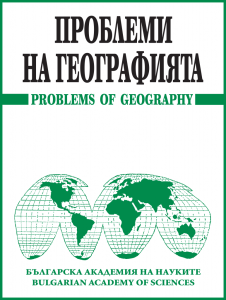Suburbanization processes in second tier cities in Bulgaria
– demographic, socio-economic, and spatial transformation of the agglomeration areas
(a case study of Plovdiv and Burgas)
Nadezhda Ilieva, Tamás Hardi, Stefan Genchev, Aleksandra Ravnachka,
Dessislava Poleganova, Szilárd Rácz, Boris Kazakov
“Problems of Geography” / „Проблеми на географията“ is a periodical of the Department of Geography at the National Institute of Geophysics, Geodesy and Geography (NIGGG) at the Bulgarian Academy of Sciences (BAS).
Volume 1-2 / Sofia 2023 / p. 63-90.
The main goal of this study is to explore the suburbanization process by analyzing the population dynamics, socio-economic and spatial transformation in the agglomeration areas of the second tier cities (according to ESPON’s classification) of Plovdiv and Burgas in Bulgaria. For the scope of the present study, three essential tiers of analysis have been defined: demographic transformation, socio-economic transformation, and changes in land cover. Depending on the population change trends (positive and negative) and the impact ofnthe two main components (natural and migratory growth), a settlement typology has been done using the methodology of Webb (1963) for the 2001–2011 and the 2011–2021 periods. Subsequently, an analysis of particular social and economic indicators has been carried out in order to track the changes and highlight the differences between the urban transformation of Burgas and Plovdiv respectively. The most valuable sources for spatial transformation analysis are the geospatial databases obtained by decoding satellite images enabling the study of land cover types and their change. Currently, various information sources are available, but as far as European countries are concerned, the database created and coordinated by the European Commission under the Copernicus programme is considered the most applicable (the layers containing information on the land imperviousness), as well as the JICA data. The agglomerations of Burgas and Plovdiv differ in terms of the type and intensity of changes in land cover in the 2006–2018 period. During the entire period, the agglomeration of Plovdiv exhibits a definite prevalence of the new land cover in its periphery, at the expense of the agglomeration core, in contrast to the agglomeration of Burgas. In the case of Plovdiv, the changes in its agglomeration periphery occur at least twice as fast as those in the agglomeration core. In the agglomeration of Burgas, on the other hand, the relative share of new types of land cover prevails in the periphery during certain time periods (2006–2009 and 2012–2015), at the expense of the size of that same class of land cover in the agglomeration core.
Keywords: agglomeration area, core-periphery, suburbanization, imperviousness, land cover



